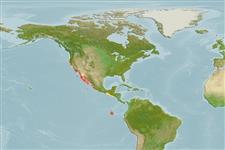>
Aulopiformes (Grinners) >
Synodontidae (Lizardfishes) > Synodontinae
Etymology: Synodus: Greek, syn, symphysis = grown together + Greek, odous = teeth (Ref. 45335).
More on author: Ayres.
Environment: milieu / climate zone / depth range / distribution range
Ökologie
seewasser riff-verbunden; tiefenbereich 1 - 229 m (Ref. 2850), usually 2 - 50 m (Ref. 9348). Subtropical; 51°N - 2°S, 128°W - 88°W
Eastern Pacific: San Francisco, USA to Cabo San Lucas and Guayamas, Mexico. Reported from British Columbia (Ref. 11980) and the Galapagos Islands (Ref. 5227).
Size / Gewicht / Alter
Maturity: Lm ? range ? - ? cm
Max length : 64.0 cm TL Männchen/unbestimmt; (Ref. 9348); common length : 30.0 cm TL Männchen/unbestimmt; (Ref. 9348)
Rückenflossenstacheln (insgesamt) : 0; Rückenflossenweichstrahlen (insgesamt) : 11 - 13; Afterflossenstacheln: 0; Afterflossenweichstrahlen: 12 - 15; Wirbelzahl: 60 - 63. Most species are brown to gray or red dorsally and laterally and pale ventrally; some species have a pattern of dusky saddles, lateral spots, or bars (Ref. 35938).
Perch motionless on pectoral fins in a wide range of habitats; commonly found on sandy bottoms or sand patches around rocky reefs and boulder and gravel strewn slopes. Active during the day. May bury in sand with only the eyes and mouth protruding (Ref. 5227). Feed on fishes (Ref. 9348). Oviparous, with planktonic eggs and larvae (Ref. 35938). Extended larval period (Ref. 35938). Catches are either discarded or made into fish meal (Ref. 9348).
Life cycle and mating behavior
Geschlechtsreife | Fortpflanzung | Ablaichen | Eier | Fecundity | Larven
Oviparous (Ref. 35938). Also Ref. 240.
Eschmeyer, W.N., E.S. Herald and H. Hammann, 1983. A field guide to Pacific coast fishes of North America. Boston (MA, USA): Houghton Mifflin Company. xii+336 p. (Ref. 2850)
IUCN Rote Liste Status (Ref. 130435: Version 2024-1)
Bedrohung für Menschen
Harmless
Nutzung durch Menschen
Fischereien: nicht kommerziell
Tools
Zusatzinformationen
Download XML
Internet Quellen
Estimates based on models
Preferred temperature (Ref.
123201): 15.2 - 25.9, mean 21.6 °C (based on 58 cells).
Phylogenetic diversity index (Ref.
82804): PD
50 = 0.5000 [Uniqueness, from 0.5 = low to 2.0 = high].
Bayesian length-weight: a=0.00479 (0.00284 - 0.00808), b=3.12 (2.97 - 3.27), in cm total length, based on LWR estimates for this species & Genus-body shape (Ref.
93245).
Trophic level (Ref.
69278): 4.5 ±0.80 se; based on food items.
Widerstandsfähigkeit (Ref.
120179): mittel, Verdopplung der Population dauert 1,4 - 4,4 Jahre. (Preliminary K or Fecundity.).
Fishing Vulnerability (Ref.
59153): Moderate to high vulnerability (46 of 100).
Nutrients (Ref.
124155): Calcium = 19.2 [6.2, 42.9] mg/100g; Iron = 0.412 [0.140, 0.958] mg/100g; Protein = 16.7 [13.7, 19.1] %; Omega3 = 0.0982 [, ] g/100g; Selenium = 22.5 [8.2, 52.2] μg/100g; VitaminA = 49.8 [12.1, 182.6] μg/100g; Zinc = 0.469 [0.266, 0.767] mg/100g (wet weight);
